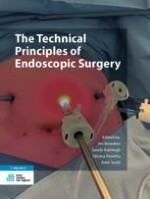Abstract
Endoscopic surgical instruments consist of three parts: a tip that is used to manipulate tissues, a shaft to transmit the motion of the handle to the tip, and a handle to control the tip. Conventional handles are based on mediaeval scissor handles. They can result in ergonomic discomfort and even a possibility of neural injury to the surgeon’s hand. This chapter deals with alternative handle designs and their benefits, as well as with general issues related to performing surgery through small incisions, resulting in a limited range of motion, mirroring and scaling of hand movements, and a lack of tactile information. These effects make it hard to carry out complex surgical procedures endoscopically. This chapter describes a number of solutions, such as dedicated semi-automated instruments and low-cost steerable instruments with graspers or scissors that can be articulated in all directions to increase the range of motion and reduce ergonomic discomfort.
